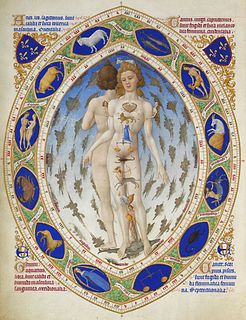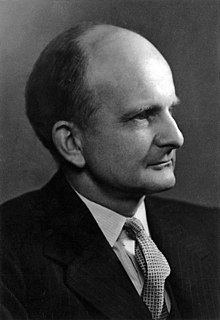Related Research Articles

Medicine is the science and practice of caring for a patient, managing the diagnosis, prognosis, prevention, treatment, palliation of their injury or disease, and promoting their health. Medicine encompasses a variety of health care practices evolved to maintain and restore health by the prevention and treatment of illness. Contemporary medicine applies biomedical sciences, biomedical research, genetics, and medical technology to diagnose, treat, and prevent injury and disease, typically through pharmaceuticals or surgery, but also through therapies as diverse as psychotherapy, external splints and traction, medical devices, biologics, and ionizing radiation, amongst others.

Neurology is a branch of medicine dealing with disorders of the nervous system. Neurology deals with the diagnosis and treatment of all categories of conditions and disease involving the central and peripheral nervous systems, including their coverings, blood vessels, and all effector tissue, such as muscle. Neurological practice relies heavily on the field of neuroscience, the scientific study of the nervous system.

Pediatrics is the branch of medicine that involves the medical care of infants, children, and adolescents. The American Academy of Pediatrics recommends people seek pediatric care through the age of 21. In the United Kingdom, paediatrics covers patients until age 18. Worldwide age limits of pediatrics have been trending up year over year. A medical doctor who specializes in this area is known as a pediatrician, or paediatrician. The word pediatrics and its cognates mean "healer of children"; they derive from two Greek words: παῖς and ἰατρός. Pediatricians work in hospitals and children's hospitals particularly those working in its subspecialties, and as outpatient primary care physicians.

Bloodletting is the withdrawal of blood from a patient to prevent or cure illness and disease. Bloodletting, whether by a physician or by leeches, was based on an ancient system of medicine in which blood and other bodily fluids were regarded as "humours" that had to remain in proper balance to maintain health. It is claimed to have been the most common medical practice performed by surgeons from antiquity until the late 19th century, a span of over 2,000 years. In Europe, the practice continued to be relatively common until the end of the 18th century. The practice has now been abandoned by modern-style medicine for all except a few very specific medical conditions. In the overwhelming majority of cases, the historical use of bloodletting was harmful to patients.
Medical ethics is an applied branch of ethics which analyzes the practice of clinical medicine and related scientific research. Medical ethics is based on a set of values that professionals can refer to in the case of any confusion or conflict. These values include the respect for autonomy, non-maleficence, beneficence, and justice. Such tenets may allow doctors, care providers, and families to create a treatment plan and work towards the same common goal. It is important to note that these four values are not ranked in order of importance or relevance and that they all encompass values pertaining to medical ethics. However, a conflict may arise leading to the need for hierarchy in an ethical system, such that some moral elements overrule others with the purpose of applying the best moral judgement to a difficult medical situation. Medical ethics is particularly relevant in decisions regarding involuntary treatment and involuntary commitment.

A prescription, often abbreviated ℞ or Rx, is a formal communication from a physician or other registered health-care professional to a pharmacist, authorizing them to dispense a specific prescription drug for a specific patient. Historically, it was a physician's instruction to an apothecary listing the materials to be compounded into a treatment—the symbol ℞ comes from the first word of a medieval prescription, Latin: Recipere, that gave the list of the materials to be compounded.

Medieval medicine in Western Europe was composed of a mixture of pseudoscientific ideas from antiquity. In the Early Middle Ages, following the fall of the Western Roman Empire, standard medical knowledge was based chiefly upon surviving Greek and Roman texts, preserved in monasteries and elsewhere. Medieval medicine is widely misunderstood, thought of as a uniform attitude composed of placing hopes in the church and God to heal all sicknesses, while sickness itself exists as a product of destiny, sin, and astral influences as physical causes. On the other hand, medieval medicine, especially in the second half of the medieval period, became a formal body of theoretical knowledge and was institutionalized in the universities. Medieval medicine attributed illnesses, and disease, not to sinful behaviour, but to natural causes, and sin was connected to illness only in a more general sense of the view that disease manifested in humanity as a result of its fallen state from God. Medieval medicine also recognized that illnesses spread from person to person, that certain lifestyles may cause ill health, and some people have a greater predisposition towards bad health than others.
Terminal illness or end-stage disease is a disease that cannot be cured or adequately treated and is reasonably expected to result in the death of the patient. This term is more commonly used for progressive diseases such as cancer, dementia or advanced heart disease than for injury. In popular use, it indicates a disease that will progress until death with near absolute certainty, regardless of treatment. A patient who has such an illness may be referred to as a terminal patient, terminally ill or simply as being terminal. There is no standardized life expectancy for a patient to be considered terminal, although it is generally months or less. Life expectancy for terminal patients is a rough estimate given by the physician based on previous data and does not always reflect true longevity. An illness which is lifelong but not fatal is a chronic condition.
Prognosis is a medical term for predicting the likely or expected development of a disease, including whether the signs and symptoms will improve or worsen or remain stable over time; expectations of quality of life, such as the ability to carry out daily activities; the potential for complications and associated health issues; and the likelihood of survival. A prognosis is made on the basis of the normal course of the diagnosed disease, the individual's physical and mental condition, the available treatments, and additional factors. A complete prognosis includes the expected duration, function, and description of the course of the disease, such as progressive decline, intermittent crisis, or sudden, unpredictable crisis.

In the history of medicine, "Islamic medicine" is the science of medicine developed in the Middle East, and usually written in Arabic, the lingua franca of Islamic civilization.
A medical specialty is a branch of medical practice that is focused on a defined group of patients, diseases, skills, or philosophy. Examples include children (paediatrics), cancer (oncology), laboratory medicine (pathology), or primary care. After completing medical school, physicians or surgeons usually further their medical education in a specific specialty of medicine by completing a multiple-year residency to become a specialist.
Traditional Mongolian medicine developed over many years among the Mongolian people. Mongolian medical practice spread across their empire and became an ingrained part of many other people's medical systems.

Richard Alan John Asher, FRCP was an eminent British endocrinologist and haematologist. As the senior physician responsible for the mental observation ward at the Central Middlesex Hospital he described and named Munchausen syndrome in a 1951 article in The Lancet.

A bimaristan, also known as dar al-shifa or simply maristan, is a hospital in the historic Islamic world.

Medicine in ancient Rome combined various techniques using different tools, methodology, and ingredients. Ancient Roman medicine was highly influenced by Greek medicine but would ultimately have its own contribution to the history of medicine through past knowledge of the Hippocratic Corpus combined with use of the treatment of diet, regimen, along with surgical procedures. This was most notably seen through the works of two of the prominent Greek Physicians, including Dioscorides and Galen, who practiced medicine and recorded their discoveries in the Roman Empire. This is contrary to two other physicians like Soranus of Ephesus and Asclepiades of Bithynia who practiced medicine both in outside territories and in ancient Roman territory, subsequently. Dioscorides was a Roman army physician, Soranus was a representative for the Methodic school of medicine, Galen performed public demonstrations, and Asclepiades was a leading Roman physician. These four physicians all had knowledge of medicine, ailments, and treatments that were healing, long lasting and influential to human history.
The doctor–patient relationship is a central part of health care and the practice of medicine. A doctor–patient relationship is formed when a doctor attends to a patient's medical needs and is usually through consent. This relationship is built on trust, respect, communication, and a common understanding of both the doctor and patients' sides. The trust aspect of this relationship goes is mutual: the doctor trusts the patient to reveal any information that may be relevant to the case, and in turn, the patient trusts the doctor to respect their privacy and not disclose this information to outside parties.

Complications: A Surgeon's Notes on an Imperfect Science is a nonfiction book collection of essays written by the American surgeon Atul Gawande. Gawande wrote this during his general surgery residency at Brigham and Women's Hospital and was published in 2002 by Picador. The book is divided into three sections: Fallibility, Mystery, and Uncertainty, all going in depth into the problems physicians may face when practicing a variety of procedures in medicine. Each of these sections puts forth different challenges doctors must face that make them imperfect and errant, resulting in the inevitable occurrence of errors.

The Bellevue Program for Survivors of Torture (PSOT) was established in 1995 as joint project of Bellevue Hospital Center and the New York University School of Medicine to address the complex needs of torture survivors residing in the New York Metropolitan area. Since its founding, the Program continues to operate from Bellevue Hospital Center, located at 462 First Avenue CD723, New York City, NY 10016. The Program is the first and largest torture treatment center in the New York City area, providing multidisciplinary and comprehensive medical, mental health, legal, and social services to victims of torture and their families. PSOT's mission is to assist individuals subjected to torture and other human rights abuses to rebuild healthy, self-sufficient lives, and contribute to global efforts to end torture. Since its inception in 1995, PSOT has provided care to help rebuild the lives of more than 5,000 men, women, and children from over 100 countries.

Dale Andrew Fisher FRACP is an Australian physician who specialises in Infectious Diseases and is a Senior Consultant in the Division of Infectious Diseases at the National University Hospital, Singapore. He is also a Professor of Medicine at the Yong Loo Lin School of Medicine, National University of Singapore, the chair of the National Infection Prevention and Control Committee through the Ministry of Health, Singapore, and chair of the steering committee of the Global Outbreak Alert and Response Network hosted by the World Health Organization.
Philip Michael Bath is a British clinician scientist. He is Stroke Association Professor of Stroke Medicine at the Stroke Trials Unit within the University of Nottingham. He specialises clinically in stroke and academically has established large-scale trials in treating and preventing stroke. Bath worked as a junior doctor before specialising in general medicine, stroke and hypertension. He is an Honorary Consultant Physician at Nottingham University Hospitals NHS Trust. He has spent his academic career at St George's, University of London, King's College London and University of Nottingham.
References
- ↑ Lancet 1949 Aug 27;2(6574):358–60
- ↑ Rowat, Bruce M.T. (1985). "Richard Asher and the Seven Sins of Medicine". Humane Health Care (Volume 1, Number 2). Archived from the original on 2007-09-27. Retrieved 2008-03-20.